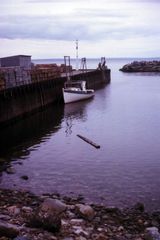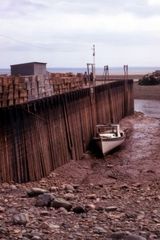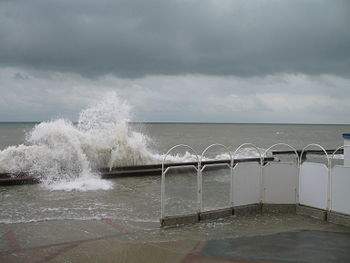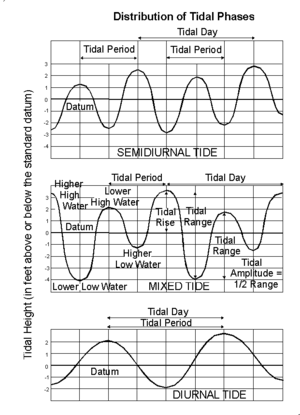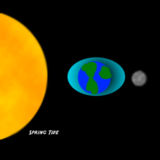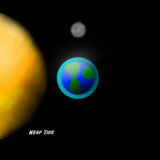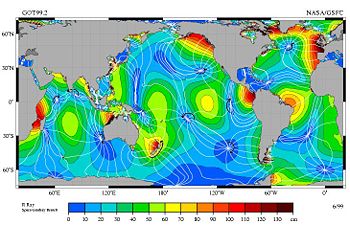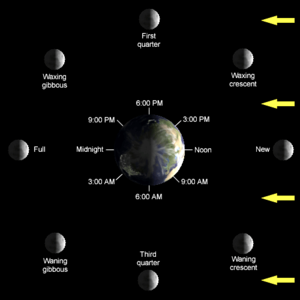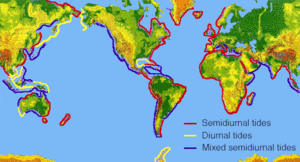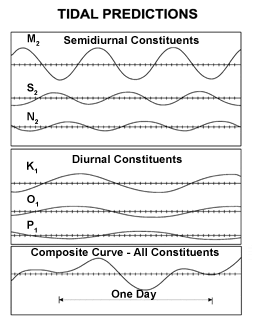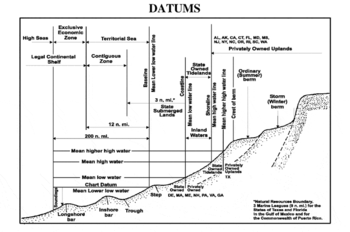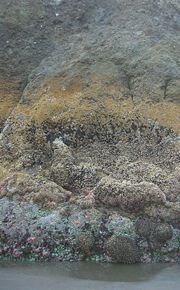Tide
2008/9 Schools Wikipedia Selection. Related subjects: Climate and the Weather; Physics
Tides are the rising and falling of Earth's ocean surface caused by the tidal forces of the Moon and the Sun acting on the oceans. Tidal phenomena can occur in any object that is subjected to a gravitational field that varies in time and space, such as the Earth's land masses. (see Other tides).
Tides noticeably affect the depth of marine and estuarine water bodies and produce oscillating currents known as tidal streams, making prediction of tides very important for coastal navigation (see Tides and navigation). The strip of seashore that is submerged at high water and exposed at low water, the intertidal zone or foreshore, is an important ecological product of ocean tides (see Intertidal ecology).
The changing tide produced at a given location is the result of the changing positions of the Moon and Sun relative to the Earth coupled with the effects of Earth rotation and the local shape of the sea floor. Sea level measured by coastal tide gauges may also be strongly affected by wind.
Introduction and tidal terminology
A tide is a repeated cycle of sea level changes in the following stages:
- Over several hours the water rises or advances up a beach in the flood
- The water reaches its highest level and stops at high water. Because tidal currents cease this is also called slack water or slack tide. The tide reverses direction and is said to be turning.
- The sea level recedes or falls over several hours during the ebb tide.
- The level stops falling at low water. This point is also described as slack or turning.
Tides may be semidiurnal (two high waters and two low waters each day), or diurnal (one tidal cycle per day). In most locations, tides are semidiurnal. Because of the diurnal contribution, there is a difference in height (the daily inequality) between the two high waters on a given day; these are differentiated as the higher high water and the lower high water in tide tables. Similarly, the two low waters each day are referred to as the higher low water and the lower low water. The daily inequality changes with time and is generally small when the Moon is over the equator.
The various frequencies of orbital forcing which contribute to tidal variations are called constituents. In most locations, the largest is the "principal lunar semidiurnal" constituent, also known as the M2 (or M2) tidal constituent. Its period is about 12 hours and 25.2 minutes, exactly half a tidal lunar day, the average time separating one lunar zenith from the next, and thus the time required for the Earth to rotate once relative to the Moon. This is the constituent tracked by simple tide clocks.
Tides vary on timescales ranging from hours to years, so to make accurate records tide gauges measure the water level over time at fixed stations which are screened from variations caused by waves shorter than minutes in period. These data are compared to the reference (or datum) level usually called mean sea level.
Constituents other than M2 arise from factors such as the gravitational influence of the Sun, the tilt of the Earth's rotation axis, the inclination of the lunar orbit and the ellipticity of the orbits of the Moon about the Earth and the Earth about the Sun. Variations with periods of less than half a day are called harmonic constituents. Long period constituents have periods of days, months, or years.
Tidal range variation: springs and neaps
The semidiurnal tidal range (the difference in height between high and low waters over about a half day) varies in a two-week or fortnightly cycle. Around new and full moon when the Sun, Moon and Earth form a line (a condition known as syzygy), the tidal forces due to the Sun reinforce those of the Moon. The tide's range is then maximum: this is called the spring tide, or just springs and is derived not from the season of spring but rather from the verb meaning "to jump" or "to leap up". When the Moon is at first quarter or third quarter, the Sun and Moon are separated by 90° when viewed from the earth, and the forces due to the Sun partially cancel those of the Moon. At these points in the lunar cycle, the tide's range is minimum: this is called the neap tide, or neaps. Spring tides result in high waters that are higher than average, low waters that are lower than average, slack water time that is shorter than average and stronger tidal currents than average. Neaps result in less extreme tidal conditions. There is about a seven day interval between springs and neaps.
The changing distance of the Moon from the Earth also affects tide heights. When the Moon is at perigee the range is increased and when it is at apogee the range is reduced. Every 7½ lunations, perigee coincides with either a new or full moon causing perigean tides with the largest tidal range. If a storm happens to be moving onshore at this time, the consequences (in the form of property damage, etc.) can be especially severe.
Tidal phase and amplitude
Because the M2 tidal constituent dominates in most locations, the stage or phase of a tide, denoted by the time in hours after high water, is a useful concept. It is also measured in degrees, with 360° per tidal cycle. Lines of constant tidal phase are called cotidal lines. High water is reached simultaneously along the cotidal lines extending from the coast out into the ocean, and cotidal lines (and hence tidal phases) advance along the coast. If one thinks of the ocean as a circular basin enclosed by a coastline, the cotidal lines point radially inward and must eventually meet at a common point, the amphidromic point. An amphidromic point is at once cotidal with high and low waters, which is satisfied by zero tidal motion. (The rare exception occurs when the tide circles around an island, as it does around New Zealand.) Indeed tidal motion generally lessens moving away from the continental coasts, so that crossing the cotidal lines are contours of constant amplitude (half of the distance between high and low water) which decrease to zero at the amphidromic point. For a 12 hour semidiurnal tide the amphidromic point behaves roughly like a clock face, with the hour hand pointing in the direction of the high water cotidal line, which is directly opposite the low water cotidal line. High water rotates about once every 12 hours in the direction of rising cotidal lines, and away from ebbing cotidal lines. The difference of cotidal phase from the phase of a reference tide is the epoch.
The shape of the shoreline and the ocean floor change the way that tides propagate, so there is no simple, general rule for predicting the time of high water from the position of the Moon in the sky. Coastal characteristics such as underwater topography and coastline shape mean that individual location characteristics need to be taken into consideration when forecasting tides; high water time may differ from that suggested by a model such as the one above due to the effects of coastal morphology on tidal flow.
Tidal physics
Isaac Newton laid the foundations for the mathematical explanation of tides in the Philosophiae Naturalis Principia Mathematica ( 1687). In 1740, the Académie Royale des Sciences in Paris offered a prize for the best theoretical essay on tides. Daniel Bernoulli, Antoine Cavalleri, Leonhard Euler, and Colin Maclaurin shared the prize. Maclaurin used Newton’s theory to show that a smooth sphere covered by a sufficiently deep ocean under the tidal force of a single deforming body is a prolate spheroid with major axis directed toward the deforming body. Maclaurin was also the first to write about the Earth's rotational effects on motion. Euler realized that the horizontal component of the tidal force (more than the vertical) drives the tide. In 1744 Jean le Rond d'Alembert studied tidal equations for the atmosphere which did not include rotation. The first major theoretical formulation for water tides was made by Pierre-Simon Laplace, who formulated a system of partial differential equations relating the horizontal flow to the surface height of the ocean. The Laplace tidal equations are still in use today. William Thomson rewrote Laplace's equations in terms of vorticity which allowed for solutions describing tidally driven coastally trapped waves, which are known as Kelvin waves.
Tidal forces
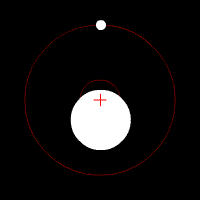
The tidal force produced by a massive object (Moon, hereafter) on a small particle located on or in an extensive body (Earth, hereafter) is the vector difference between the gravitational force exerted by the Moon on the particle, and the gravitational force that would be exerted on the particle if it were located at the centre of mass of the Earth. Thus, the tidal force depends not on the strength of the gravitational field of the Moon, but on its gradient. The gravitational force exerted on the Earth by the Sun is on average 179 times stronger than that exerted on the Earth by the Moon, but because the Sun is on average 389 times farther from the Earth, the gradient of its field is weaker. The tidal force produced by the Sun is therefore only 46% as large as that produced by the Moon.
Tidal forces can also be analyzed from the point of view of a reference frame that translates with the centre of mass of the Earth. Consider the tide due to the Moon (the Sun is similar). First observe that the Earth and Moon rotate around a common orbital centre of mass, as determined by their relative masses. The orbital center of mass is 3/4 of the way from the Earth's centre to its surface. The second observation is that the Earth's centripetal motion is the averaged response of the entire Earth to the Moon's gravity and is exactly the correct motion to balance the Moon's gravity only at the center of the Earth; but every part of the Earth moves along with the centre of mass and all parts have the same centripetal motion, since the Earth is rigid. On the other hand each point of the Earth experiences the Moon's radially decreasing gravity differently; the near parts of the Earth are more strongly attracted than is compensated by inertia and experience a net tidal force toward the Moon; the far parts have more inertia than is necessary for the reduced attraction, and thus feel a net force away from the Moon. Finally only the horizontal components of the tidal forces actually contribute tidal acceleration to the water particles since there is small resistance. The actual tidal force on a particle is only about a ten millionth of the force caused by the Earth's gravity.
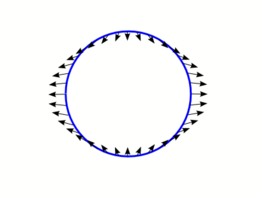
The ocean's surface is closely approximated by an equipotential surface, (ignoring ocean currents) which is commonly referred to as the geoid. Since the gravitational force is equal to the gradient of the potential, there are no tangential forces on such a surface, and the ocean surface is thus in gravitational equilibrium. Now consider the effect of external, massive bodies such as the Moon and Sun. These bodies have strong gravitational fields that diminish with distance in space and which act to alter the shape of an equipotential surface on the Earth. Gravitational forces follow an inverse-square law (force is inversely proportional to the square of the distance), but tidal forces are inversely proportional to the cube of the distance. The ocean surface moves to adjust to changing tidal equipotential, tending to rise when the tidal potential is high, the part of the Earth nearest the Moon, and the farthest part. When the tidal equipotential changes, the ocean surface is no longer aligned with it, so that the apparent direction of the vertical shifts. The surface then experiences a down slope, in the direction that the equipotential has risen.
Laplace tidal equation
The depth of the oceans is much smaller than their horizontal extent; thus, the response to tidal forcing can be modelled using the Laplace tidal equations which incorporate the following features: (1) the vertical (or radial) velocity is negligible, and there is no vertical shear—this is a sheet flow. (2) The forcing is only horizontal (tangential). (3) the Coriolis effect appears as a fictitious lateral forcing proportional to velocity. (4) the rate of change of the surface height is proportional to the negative divergence of velocity multiplied by the depth. The last means that as the horizontal velocity stretches or compresses the ocean as a sheet, the volume thins or thickens, respectively. The boundary conditions dictate no flow across the coastline, and free slip at the bottom. The Coriolis effect steers waves to the right in the northern hemisphere and to the left in the southern allowing coastally trapped waves. Finally, a dissipation term can be added which is an analog to viscosity.
Tidal amplitude and cycle time
The theoretical amplitude of oceanic tides due to the Moon is about 54 cm at the highest point, which corresponds to the amplitude that would be reached if the ocean possessed a uniform depth, there were no landmasses, and the Earth were not rotating. The Sun similarly causes tides, of which the theoretical amplitude is about 25 cm (46% of that of the Moon) with a cycle time of 12 hours. At spring tide the two effects add to each other to a theoretical level of 79 cm, while at neap tide the theoretical level is reduced to 29 cm. Since the orbits of the Earth about the Sun, and the Moon about the Earth, are elliptical, the amplitudes of the tides change somewhat as a result of the varying Earth-Sun and Earth-Moon distances. This causes a variation in the tidal force and theoretical amplitude of about ±18% for the Moon and ±5% for the Sun. If both the Sun and Moon were at their closest positions and aligned at new moon, the theoretical amplitude would reach 93 cm.
Real amplitudes differ considerably, not only because of variations in ocean depth, and the obstacles to flow caused by the continents, but also because the natural period of wave propagation is of the same order of magnitude as the rotation period: about 30 hours. If there were no land masses, it would take about 30 hours for a long wavelength ocean surface wave to propagate along the equator halfway around the Earth (by comparison, the natural period of the Earth's lithosphere is about 57 minutes).
Tidal dissipation
The tidal oscillations of the Earth introduce dissipation, at an average rate of about 3.75 terawatt. About 98% of this dissipation is by the tidal movement in the seas and oceans. The dissipation arises as the basin-scale tidal flow drives smaller-scale flows which experience turbulent dissipation. This tidal drag gives rise to a torque on the Moon that results in the gradual transfer of angular momentum to its orbit, and a gradual increase in the Earth-Moon separation. As a result of the principle of conservation of angular momentum, the rotational velocity of the Earth is correspondingly slowed. Thus, over geologic time, the Moon recedes from the Earth, at about 3.8 cm/year, and the length of the terrestrial day increases, meaning that there is about 1 fewer day per 100 million years. See tidal acceleration for further details.
Tidal observation and prediction
From ancient times, tides have been observed and discussed with increasing sophistication, first noting the daily recurrence, then its relationship to the Sun and Moon. Pytheas travelled to the British Isles and seems to be the first to have related spring tides to the phase of the moon. The Naturalis Historia of Pliny the Elder collates many observations of detail: the spring tides being a few days after (or before) new and full moon, and that the spring tides around the time of the equinoxes were the highest, though there were also many relationships now regarded as fanciful. In his Geography, Strabo described tides in the Persian Gulf having their greatest range when the moon was furthest from the plane of the equator. All this despite the relatively feeble tides in the Mediterranean basin, though there are strong currents through the Strait of Messina and between Greece and the island of Euboea through the Euripus that puzzled Aristotle. In Europe around 730 A.D. the Venerable Bede described how the rise of tide on one coast of the British Isles coincided with the fall on the other and described the progression in times of the same high water along the Northumbrian coast.
Eventually the first tide table in China was recorded in 1056 A.D, primarily for the benefit of visitors wishing to see the famous tidal bore in the Qiantang River. The first known tide table is thought to be that of John, Abbott of Wallingford (d. 1213), based on high water occurring 48 minutes later each day, and three hours later upriver at London than at the mouth of the Thames.
William Thomson led the first systematic harmonic analysis of tidal records starting in 1867. The main result was the building of a tide-predicting machine (TPM) using a system of pulleys to add together six harmonic functions of time. It was "programmed" by resetting gears and chains to adjust phasing and amplitudes. Similar machines were used until the 1960s.
The first known sea-level record of an entire spring–neap cycle was made in 1831 on the Navy Dock in the Thames Estuary, and many large ports had automatic tide gage stations by 1850.
William Whewell first mapped co-tidal lines ending with a nearly global chart in 1836. In order to make these maps consistent, he hypothesized the existence of amphidromes where co-tidal lines meet in the mid-ocean. These points of no tide were confirmed by measurement in 1840 by Captain Hewett, RN, from careful soundings in the North Sea.
Timing
In most places there is a delay between the phases of the Moon and the effect on the tide. Springs and neaps in the North Sea, for example, are two days behind the new/full Moon and first/third quarter. This is called the age of the tide.
The exact time and height of the tide at a particular coastal point is also greatly influenced by the local bathymetry. There are some extreme cases: the Bay of Fundy, on the east coast of Canada, features the largest well-documented tidal ranges in the world, 16 metres (53 ft), because of the shape of the bay. Southampton in the United Kingdom has a double high water caused by the interaction between the different tidal harmonics within the region. This is contrary to the popular belief that the flow of water around the Isle of Wight creates two high waters. The Isle of Wight is important, however, as it is responsible for the 'Young Flood Stand', which describes the pause of the incoming tide about three hours after low water. Ungava Bay in Northern Quebec, north eastern Canada, is believed by some experts to have higher tidal ranges than the Bay of Fundy (about 17 metres or 56 ft), but it is free of pack ice for only about four months every year, whereas the Bay of Fundy rarely freezes.
Because the oscillation modes of the Mediterranean Sea and the Baltic Sea do not coincide with any significant astronomical forcing period the largest tides are close to their narrow connections with the Atlantic Ocean. Extremely small tides also occur for the same reason in the Gulf of Mexico and Sea of Japan. On the southern coast of Australia, because the coast is extremely straight (partly due to the tiny quantities of runoff flowing from rivers), tidal ranges are equally small.
Tidal analysis
It was the universal theory of gravitation due to Isaac Newton that first enabled an explanation of why there were two tides a day, not one, and, via calculation of the forces, offered hope of detailed understanding. Although it may seem that tides could be predicted via a sufficiently detailed knowledge of the astronomical forcing terms, the actual tide at a given location is determined by the response of the oceans to the astronomical forces accumulated over a period of many days and to calculate this requires a detailed knowledge of the shape of all the ocean basins. Instead, the procedure is pragmatic. At each location of interest, measure the tide heights over at least a lunar cycle (to capture the spring - neap tidal response) and then analyse the differences from mean sea level with respect to the known astronomical frequencies and phases of the tide-raising forces on the expectation that the tide height behaviour will follow the behaviour of the tide force. Then, because astronomical states can be calculated with certainty, the tide height at other times can be predicted. The main patterns are the twice-daily tide, the difference between the first and second tide of a day (due to the moon and sun being north or south of the equator), the spring-neap cycle in amplitude (due to the relative positions of the moon and sun), and the adjustment of spring tide heights due to the perigees of the moon and sun. The Highest Astronomical Tide is the perigean spring tide when both the sun and the moon are closest to the earth.
When confronted by a periodically varying function, the standard approach is to employ Fourier series, a form of orthogonal analysis that uses trigonometrical functions as its basis set, specifically a collection of sinusoidal functions having frequencies (the number of cycles per day, or other convenient unit) that are zero, one, two, three, etc. times the frequency of a particular fundamental cycle; these are called harmonics of the fundamental frequency, and the process is termed Harmonic Analysis. If sinusoidal functions are well-suited to the behaviour being modelled, relatively few harmonic terms need to be carried in the analysis, and fortunately, because orbital paths are circular, sinusoidal variations are very suitable.
For the analysis of tide heights, the Fourier Series approach is best made more elaborate. While the theorem remains true and the tidal height could be analysed in terms of a single frequency and its harmonics, a large number of significant terms would be required. A much better (i.e. more compact) decomposition for this case involves a basis set having more than one fundamental frequency: specifically, the periods of one revolution of the earth (equivalently, of the sun around the earth), and one orbit of the moon about the earth are incommensurable (for simplicity in phrasing, this discussion is entirely geocentric, but is informed by the heliocentric model) so to represent both influences via one frequency would require many harmonic terms. That is, the sum of two sinusoids, one at the sun's frequency and the second at the moon's frequency, requires those two terms only, but their representation as a Fourier Series having one fundamental frequency and its (integer) multiples would require many terms. For tides then, although the process is still termed Harmonic Analysis, it does not limit itself to harmonics of a single frequency. To demonstrate this, http://www.arachnoid.com/tides/index.html offers a tidal height pattern converted into a .mp3 sound file, and the rich sound is quite different from a pure tone. In still other words, the harmonies are multiples of many fundamental frequencies, not just of the one fundamental frequency of the common Fourier series approach.
The study of tide height by Harmonic Analysis was begun by Laplace, Lord Kelvin and George Darwin, then rigorously extended by A.T. Doodson who introduced the Doodson Number notation to organise the hundreds of terms that result. This approach has been the international standard ever since, and the complications arise as follows: so far, the tide-raising force is notionally given by A.cos(w.t + p) where A is the amplitude, w the angular frequency (usually given in degrees per hour) and p the phase offset with regard to the astronomical state at time t = 0; there is a term for the moon and a second term for the sun. If the orbits were circular, that would be the end of the matter, but of course they're not. Accordingly, the value of A is itself varying with time, slightly, about some average figure. Replace it then by A(t), but, what functional form? It turns out that another sinusoid gives an excellent approximation, rather like the cycles and epicycles of Ptolemaic theory. Accordingly, A(t) = A.(1 + Aa.cos(wa.t + pa)), which is to say an average value A with a sinusoidal variation about it of magnitude Aa, with frequency wa and phase pa. Thus the simple term is now a compound term, the product of two cosine terms: A.[1 + Aa.cos(wa + pa)].cos(w.t + p)
Now, given that cos(a).cos(b) = [cos(a + b) + cos(a - b)]/2, it is clear that a compound term involving the product of two cosine terms each with their own frequency is the same as three (not two: it is (1 + cos).cos) simple cosine terms that are to be added, at the original frequency and also at the sum and difference of the two frequencies of the product term. Consider further that the tidal force on a location depends also on whether the moon (or the sun) is above or below the plane of the equator, and that these attributes have their own periods also incommensurable with a day and a month, and it is clear that many combinations result. With a careful choice of the basic astronomical frequencies, the Doodson Number annotates the particular additions and differences of them to form the frequency of each simple cosine term.
Remember always that the astronomical tides do not include the effect of weather, and, changes to local conditions (sandbank movement, dredging harbour mouths, etc.) away from those prevailing at the time of measurement can affect the timing and magnitude of the actual tide. Organisations quoting a "highest astronomical tide" for some location can exaggerate the figure as a safety factor against uncertainties of analysis, extrapolation from the nearest point of measurement, changes since the time of observation, possible ground subsidence, etc. to protect the organisation against blame should an engineering work be overtopped. If the size of a "weather surge" is assessed by subtracting the astronomical tide from the observed tide at the time, care is needed.
Careful Fourier data analysis over a nineteen-year period (the National Tidal Datum Epoch in the US) uses frequencies called the tidal harmonic constituents. Nineteen years is preferred because the relative positions of the earth, moon and sun repeat almost exactly in the Metonic cycle of 18.6 years. This analysis can be done using only the knowledge of the period of forcing, but without detailed understanding of the physical mathematics, which means that useful tidal tables have been constructed for centuries. The resulting amplitudes and phases can then be used to predict the expected tides. These are usually dominated by the constituents near 12 hours (the semidiurnal constituents), but there are major constituents near 24 hours (diurnal) as well. Longer term constituents are 14 day or fortnightly, monthly, and semiannual. Most of the coastline is dominated by semidiurnal tides, but some areas such as the South China Sea and the Gulf of Mexico are primarily diurnal. In the semidiurnal areas, the primary constituents M2(lunar) and S2(solar) periods differ slightly so that the relative phases, and thus the amplitude of the combined tide, change fortnightly (fourteen day period).
In the M2 plot above each cotidal line differs by one hour from its neighbors, and the thicker lines show tides in phase with equilibrium at Greenwich. The lines rotate around the amphidromic points counterclockwise in the northern hemisphere so that from Baja California to Alaska and from France to Ireland the M2 tide propagates northward. In the southern hemisphere this direction is clockwise. On the other hand M2 tide propagates counterclockwise around New Zealand, but this because the islands act as a dam and permit the tides to have different heights on opposite sides of the islands. But the tides do propagate northward on the east side and southward on the west coast, as predicted by theory. The exception is the Cook Strait where the tidal currents periodically link high to low water. This is because cotidal lines 180° around the amphidromes are in opposite phase, for example high water across from low water. Each tidal constituent has a different pattern of amplitudes, phases, and amphidromic points, so the M2 patterns cannot be used for other tide components.
Tidal Current
The flow pattern due to tidal influence is much more difficult to analyse, and also, data is much more difficult to collect. A tidal height is a simple number, and applies to a wide region simultaneously (often as far as the eye can see), but a flow has both a magnitude and a direction, and can vary substantially over just a short distance due to local bathymetry, and also vary with depth. Although the centre of a channel is the most useful measuring site, mariners will not accept a current measuring installation obstructing navigation! A flexible attitude is required. A flow proceeding up a curved channel is the same flow, even though its direction varies continuously along the channel. Even the obvious expectation that the flood and ebb flows will be in reciprocal directions is not met, as the direction of a flow is determined by the shape of the channel it is coming from, not the shape where it will shortly be. Likewise, eddies can form in one direction but not the other.
Nevertheless, analysis proceeds on the same basis. At a given location in the simple case, the great majority of the flood flow will be in one direction, and the ebb flow in another (not necessarily reciprocal) direction. Take the velocities along the flood direction as positive, and along the ebb direction as negative, and proceed as if these were tide height figures. In more complex situations, the flow will not be dominated by the main ebb and flow directions, with the flow direction and magnitude tracing out an ellipse over a tidal cycle (on a polar plot) instead of along the two lines of ebb and flow direction. In this case, analysis might proceed along two pairs of directions, the primary flow directions and the secondary directions at right angles. Alternatively, the tidal flows can be treated as complex numbers, as each value has both a magnitude and a direction.
As with tide height predictions, tide flow predictions based only on astronomical factors do not take account of weather conditions, which can completely change the situation. The tidal flow through Cook Strait between the two main islands of New Zealand is particularly interesting, as on each side of the strait the tide is almost exactly out of phase so that high water on one side meets low water on the other. Strong currents result, with almost zero tidal height change in the centre of the strait. Yet, although the tidal surge should flow in one direction for six hours and then the reverse direction for six hours, etc. a particular surge might last eight or ten hours with the reverse surge enfeebled. In especially boisterous weather conditions, the reverse surge might be entirely overcome so that the flow remains in the same direction through three surge periods and longer.
A further complication for Cook Strait's pattern of current flow is that the tides at the north end have the common two cycles of spring-neap tides in a month (as found along the west side of the country), but the south end's tidal pattern has one cycle of spring-neap tides a month, as found on the east side of the country. Tidal currents are much more complex than tidal heights!
Tidal Power Generation
Power can be extracted by two means: inserting a water turbine into a tidal current, or, building impoundment ponds so as to release or admit water through a turbine. In the first case, the generation is entirely determined by the timing and magnitude of the tidal currents, and the best currents may be unavailable because the turbines would obstruct navigation. In the second, the impoundment dams are expensive to construct, the natural water cycles are completely disrupted, as is navigation, but with multiple impoundment ponds power can be generated at chosen times. So far, there are few systems for tidal power generation (most famously, La Rance by Saint Malo, France) and many difficulties. Aside from environmental issues, simply withstanding sea-water corrosion and fouling by biological growths is difficult!
Proponents of tidal power systems usually boast that unlike wind power systems, the generation pattern can be predicted years ahead, and prefer not to talk about weather effects. Another assertion is that some generation is possible for most of the tidal cycle. This may be true in principle since the time of still water is short, but in practice turbines lose efficiency at partial operating powers. Since the power available from a flow is proportional to the cube of the flow speed, the times during which high power generation is possible turn out to be rather brief. An obvious fallback then is to have a number of tidal power generation stations, at locations where the tide phase is different enough so that low power from one station is filled in by high power from another. Again, New Zealand has particularly interesting opportunities. Because the tidal pattern is such that a state of high water orbits the country once per cycle, there is always somewhere around the coast where the tide is at its peak, and somewhere else where it is at its lowest, etc. so that via the electricity transmission network, there could always be supply from tidal generation somewhere. The most convenient situation is presented with Auckland city, which is between Manukau harbour and Waitemata harbour so that both power stations would be close to the load.
But, because the power available varies with the cube of the flow, even with the optimum phase difference of three hours between two stations, there are still significant amounts of time when neither tidal flow is rapid enough for significant generation, and worse, during the time of neap tides, the flow is weak all of the day, and there is no getting around this via multiple stations, because the neap tides apply to the whole earth at once. The most feeble neap tides would be when the sun's influence is maximum whilst the moon's is weakest, and as far as the sun is concerned, it is closest to the earth during the time of the southern hemisphere's summer, which is when electricity demand is the least there, a small bonus.
As a result, interest must fall on the Kaipara harbour which not only is large, but also is two-lobed in shape, and thus almost pre-designed for a tidal impoundment scheme where one lobe could be filled by high water and the other emptied by a low water, and then via a canal from one to the other generation would be possible at a time of choice.
There is scant likelihood of any such scheme proceeding, due to the disruption to natural conditions.
Tides and navigation
Tidal flows are of profound importance in navigation and very significant errors in position will occur if they are not taken into account. Tidal heights are also very important; for example many rivers and harbours have a shallow "bar" at the entrance which will prevent boats with significant draft from entering at certain states of the tide.
The timings and velocities of tidal flow can be found by looking at a tidal chart or tidal stream atlas for the area of interest. Tidal charts come in sets, with each diagram of the set covering a single hour between one high water and another (they ignore the extra 24 minutes) and give the average tidal flow for that one hour. An arrow on the tidal chart indicates the direction and the average flow speed (usually in knots) for spring and neap tides. If a tidal chart is not available, most nautical charts have " tidal diamonds" which relate specific points on the chart to a table of data giving direction and speed of tidal flow.
Standard procedure to counteract the effects of tides on navigation is to (1) calculate a " dead reckoning" position (or DR) from distance and direction of travel, (2) mark this on the chart (with a vertical cross like a plus sign) and (3) draw a line from the DR in the direction of the tide. The distance the tide will have moved the boat along this line is computed by the tidal speed, and this gives an "estimated position" or EP (traditionally marked with a dot in a triangle).
Nautical charts display the "charted depth" of the water at specific locations with " soundings" and the use of bathymetric contour lines to depict the shape of the submerged surface. These depths are relative to a " chart datum", which is typically the level of water at the lowest possible astronomical tide (tides may be lower or higher for meteorological reasons) and are therefore the minimum water depth possible during the tidal cycle. "Drying heights" may also be shown on the chart, which are the heights of the exposed seabed at the lowest astronomical tide.
Heights and times of low and high water on each day are published in tide tables. The actual depth of water at the given points at high or low water can easily be calculated by adding the charted depth to the published height of the tide. The water depth for times other than high or low water can be derived from tidal curves published for major ports. If an accurate curve is not available, the rule of twelfths can be used. This approximation works on the basis that the increase in depth in the six hours between low and high water will follow this simple rule: first hour - 1/12, second - 2/12, third - 3/12, fourth - 3/12, fifth - 2/12, sixth - 1/12.
Biological aspects
Intertidal ecology
Intertidal ecology is the study of intertidal ecosystems, where organisms live between the low and high water lines. At low water, the intertidal is exposed (or ‘emersed’) whereas at high water, the intertidal is underwater (or ‘immersed’). Intertidal ecologists therefore study the interactions between intertidal organisms and their environment, as well as between different species of intertidal organisms within a particular intertidal community. The most important environmental and species interactions may vary based on the type of intertidal community being studied, the broadest of classifications being based on substrates - rocky shore and soft bottom communities.
Organisms living in this zone have a highly variable and often hostile environment, and have evolved various adaptations to cope with and even exploit these conditions. One easily visible feature of intertidal communities is vertical zonation, where the community is divided into distinct vertical bands of specific species going up the shore. Species ability to cope with desiccation determines their upper limits, while competition with other species sets their lower limits.
Intertidal regions are utilized by humans for food and recreation, but anthropogenic actions also have major impacts, with overexploitation, invasive species and climate change being among the problems faced by intertidal communities. In some places Marine Protected Areas have been established to protect these areas and aid in scientific research.
Biological rhythms and the tides
Intertidal organisms are greatly affected by the approximately fortnightly cycle of the tides, and hence their biological rhythms tend to occur in rough multiples of this period. This is seen not only in the intertidal organisms however, but also in many other terrestrial animals, such as the vertebrates. Examples include gestation and the hatching of eggs. In humans, for example, the menstrual cycle lasts roughly a month, an even multiple of the period of the tidal cycle. This may be evidence of the common descent of all animals from a marine ancestor.
Other tides
In addition to oceanic tides, there are atmospheric tides as well as earth tides. All of these are continuum mechanical phenomena, the first two being fluids and the third solid (with various modifications).
Atmospheric tides are negligible from ground level and aviation altitudes, drowned by the much more important effects of weather. Atmospheric tides are both gravitational and thermal in origin, and are the dominant dynamics from about 80 km to 120 km where the molecular density becomes too small to behave as a fluid.
Earth tides or terrestrial tides affect the entire rocky mass of the Earth. The Earth's crust shifts (up/down, east/west, north/south) in response to the Moon's and Sun's gravitation, ocean tides, and atmospheric loading. While negligible for most human activities, the semidiurnal amplitude of terrestrial tides can reach about 55 cm at the equator (15 cm is due to the Sun) which is important in GPS calibration and VLBI measurements. Also to make precise astronomical angular measurements requires knowledge of the earth's rate of rotation and nutation, both of which are influenced by earth tides. The semi-diurnal M2 Earth tides are nearly in phase with the Moon with tidal lag of about two hours. Terrestrial tides also need to be taken in account in the case of some particle physics experiments. For instance, at the CERN or SLAC, the very large particle accelerators were designed while taking terrestrial tides into account for proper operation. Among the effects that need to be taken into account are circumference deformation for circular accelerators and particle beam energy. Since tidal forces generate currents of conducting fluids within the interior of the Earth, they affect in turn the Earth's magnetic field itself.
When oscillating tidal currents in the stratified ocean flow over uneven bottom topography, they generate internal waves with tidal frequencies. Such waves are called internal tides.
The galactic tide is the tidal force exerted by galaxies on stars within them and satellite galaxies orbiting them. The effects of the galactic tide on the Solar System's Oort cloud are believed to be the cause of 90 percent of all observed long-period comets.
Misapplications
Tsunamis, the large waves that occur after earthquakes, are sometimes called tidal waves, but this name is due to their resemblance to the tide, rather than any actual link to the tide itself. Other phenomena unrelated to tides but using the word tide are rip tide, storm tide, hurricane tide, and black or red tides. The term tidal wave appears to be disappearing from popular usage.
